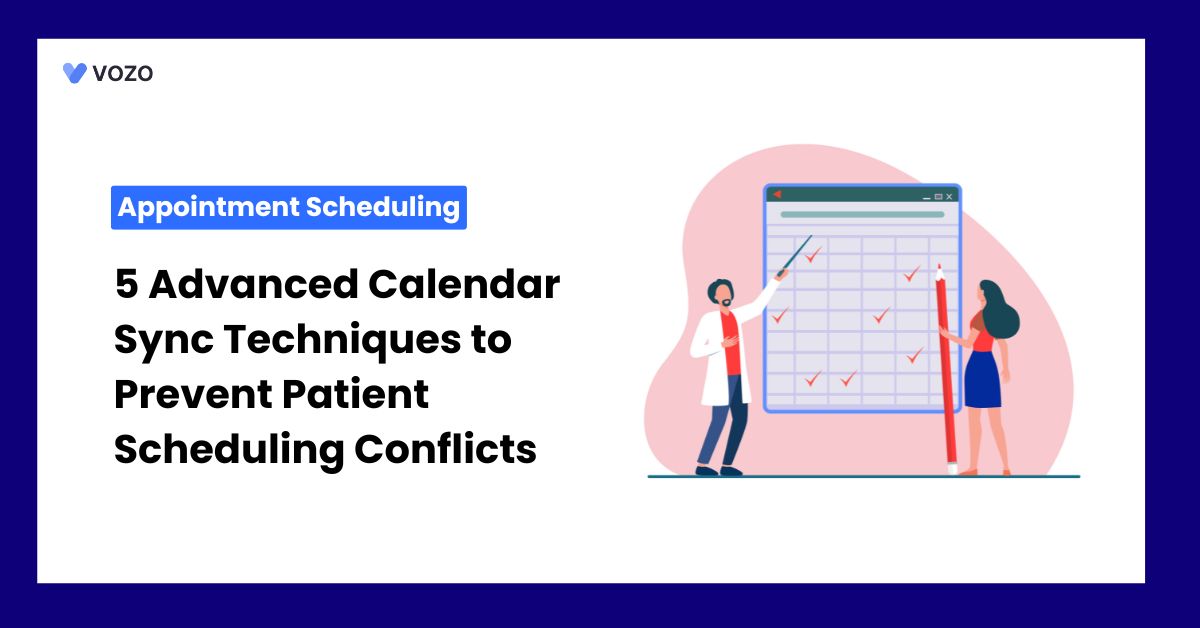5 Advanced Calendar Sync Techniques to Prevent Patient Scheduling Conflicts
Optimized patient scheduling holds great importance for a healthcare practice but calendar conflicts can result in missed appointments, patient dissatisfaction, and inefficiencies in operations. Advanced calendar synchronization techniques are paramount for the upkeep of an operationally seamless scheduling system.
In this blog, we have shared the five powerful strategies for preventing double bookings, decreasing no-shows, and ensuring the smooth interaction between patients, providers, and administrative teams. These advanced solutions will assist you in scheduling appointments for a small clinic or a large healthcare facility more efficiently, thus improving the patient’s experience and overall efficiency of workflows.
Importance of Efficient Patient Scheduling
Efficient scheduling helps doctors manage time and resources without unnecessary stress. Patients get timely care without long waiting hours or last-minute changes. Clinics operate smoothly when appointments are planned and properly spaced out. An efficient system helps doctors focus on their patients’ needs.
Well-organized schedules reduce patient waiting times and improve medical efficiency. Doctors can see more patients without feeling rushed or overwhelmed daily. Patients appreciate an organized schedule that values their time and convenience. A structured system prevents confusion and scheduling errors in medical facilities.
A report by MGMA highlights problems caused by inefficient appointment scheduling. It states that poor scheduling leads to lost revenue and delays. Late or missed appointments affect both doctors and patients significantly. Clinics that improve scheduling prevent unnecessary stress and wasted time.
Related: The Importance of Adapting Online Appointment Scheduling System in Healthcare
Challenges of Scheduling Conflicts
Scheduling conflicts create confusion in hospitals, clinics, and medical centers daily. Double bookings result in long waiting times and unhappy patients overall. Staff members struggle when sudden changes disrupt the planned appointment schedule. Some major challenges include:
- Patients are scheduled at the same time due to system errors or miscommunication.
- When multiple locations or departments don’t share scheduling information can lead to confusion.
- Patients canceling at the last moment might leave open slots that could have been filled.
- Patients missing appointments without informing the clinic
To tackle these issues, a strong scheduling system is important. It helps clinics to avoid these common scheduling problems.
How Advanced Calendar Sync Techniques Can Help to Prevent Patient Scheduling Conflicts
1. Implement Real-Time Calendar Synchronization
Real-time updates keep schedules accurate and prevent appointment-related issues. Staff members can check schedules and adjust changes instantly if needed.
This prevents double bookings and reduces scheduling errors in healthcare centers. Patients receive accurate appointment details without last-minute modifications or confusion.
- Cloud-based scheduling systems update appointment details across all platforms automatically.
- Online bookings reflect immediately across all devices without additional manual work.
- Doctors and staff always have the latest appointment details available.
- This reduces scheduling conflicts and ensures smoother operations for medical teams.
Modern scheduling tools help clinics avoid daily appointment conflicts. Most tools detect overlapping schedules before problems arise unexpectedly.
- If two patients are scheduled incorrectly, staff members receive immediate alerts.
- Fixing scheduling mistakes early saves time for doctors and patients.
2. Use Smart Appointment Buffers
Adding small time gaps between appointments prevents unnecessary delays in clinics. These buffers give doctors extra time before their next patient arrives.
Small gaps prevent doctors from rushing between consecutive appointments each day. Due to a well-structured schedule, patients experience shorter wait times.
- A standard 10–15 minute buffer keeps appointment schedules more flexible.
- Longer appointments may need extended buffers depending on patient requirements.
- Automated scheduling tools can set smart buffer times between appointments.
- These systems adjust buffer gaps based on appointment length effectively.
Buffer times help prevent crowded waiting rooms at busy medical centers.
- When appointments run late, patients experience unnecessary frustration and delays.
- Additional buffer time prevents scheduling issues from creating more patient discomfort.
- A structured buffer system enhances efficiency in daily clinic operations.
Related: 6 Ways to Make EHR Appointment Scheduling Process More Efficient
3. Prioritize Appointments with Smart Scheduling
Not all appointments require the same urgency or scheduling priority daily. Some require immediate attention while others can wait a little longer. Clinics should organize schedules based on patient needs and urgency. This ensures emergency cases receive priority over routine checkups easily.
- Grouping appointments based on urgency improves time management for clinics.
- Routine checkups should not take priority over urgent medical cases.
- Emergency visits need to be scheduled in the earliest available slots.
- This ensures doctors focus on critical patients first before routine cases.
Advanced scheduling software organizes appointments based on urgency levels automatically. Some scheduling tools analyze patient data to determine priority orders.
- Clinics using priority scheduling see noticeable improvements in appointment management.
- Patients with urgent needs receive faster care with proper prioritization.
4. Centralize Multi-Clinic Scheduling
Healthcare centers with multiple locations need synchronized scheduling across all branches. A shared system prevents booking errors and appointment mix-ups entirely.
Staff members in different locations can easily view and update schedules, which helps prevent miscommunication between clinics and staff members.
- Increased collaboration and coordination among health professionals can be ensured with the help of a centralized scheduling platform.
- With clinics operating independently, scheduling may often vary within the locations themselves.
- Multi-location synchronization prevents scheduling conflicts within different clinic branches.
- Patients receive consistent service across all medical locations available.
Appointment hours are standardized and organized in different places throughout the clinic.
- Each clinic should have the same policies for rescheduling, cancellation, and being late.
- Make Consistent scheduling scope so that human error can be minimized while transferring patients from one medical center to the other.
- No matter where the patient sees the doctor, the patient will consistently receive the same care.
5. Automate Appointment Reminders and Confirmations
Missed appointments frustrate clinics and patients daily. Many patients forget their scheduled appointments without prior reminders.
Automated messages help patients remember their upcoming appointments more effectively. Sending reminders reduces last-minute cancellations and unexpected scheduling conflicts.
- Text messages, email, and phone reminders work well for patient notifications.
- Many patients prefer text messages over phone calls for appointment updates.
- Clinics should send appointment reminders a few days before scheduled visits.
- This gives patients enough time to confirm or reschedule conveniently.
Automated confirmation systems improve clinic scheduling and time management processes.
- Patients can confirm appointments with a simple response to messages.
- If they cancel, the system automatically updates the scheduling database.
- This allows clinics to quickly offer unfilled slots to other patients.
Related: The Best Practices for Patient Appointment Scheduling with EHR
Vozo Cloud EHR Integrated with Scheduling System for your Healthcare Practice
If you are searching for the best EHR system for your healthcare practice, Vozo EHR can be your go-to choice. Our comprehensive EHR solution lets you focus more on patient care while carrying all the burdens and simplifying it.
- Vozo Cloud EHR’s cost-effective cloud subscription benefits all levels of practice.
- Our feature-rich EHR helps you rectify mistakes efficiently and speed up the process.
- Vozo Specialty EHR resonates with specialty practice needs and requirements.
- Our expert technical team got you covered 24/7 if any needs arise.
- Our EHR System continues to scale as your healthcare practice grows to improve the user experience.
The Vozo Customized EHR solution benefits your healthcare practice by:
- Streamlining the administrative process
- Improving workflow efficiency
- Reducing proneness to errors
- Manages all the patient’s records in one place
- Offers greater efficiency and cost-savings across the board.
Our specialty-specific tools like scheduling, patient portals, lab integration, cloud hosting, and more meet the specific needs and requirements of your healthcare practice.
“Embrace Vozo EHR to Reduce Your Burdens and Enhance Patient Care”
About the author

With more than 4 years of experience in the dynamic healthcare technology landscape, Sid specializes in crafting compelling content on topics including EHR/EMR, patient portals, healthcare automation, remote patient monitoring, and health information exchange. His expertise lies in translating cutting-edge innovations and intricate topics into engaging narratives that resonate with diverse audiences.













